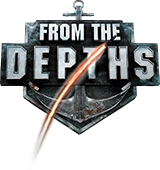Water is the lowest traversable domain, lying below the air.
Bouyancy and Displacement[ | ]
Although termed "water", it really isn't. For the sake of FUN, atmospheric and hydrodynamic drag on Neter and Glao are orders of magnitude higher than on planet earth, and perceptive builders will also notice that their creations, and especially ships, whose physical dimensions (length, beam, draught, and block coefficient) are fairly easily measured, will be far heavier than expected. This shouldn't cause you too much trouble since the game itself remains somewhat internally consistent, but there are some situations where confusion may arise;
One is when attempting to use real-world naval treaties as a basis for ship design, where one will find that attempting to build a 10'000 -"weight" cruiser will yield a vessel the size of your average houseboat.
Another is when attempting to use real-world hobby tools like Springsharp to make general predictions regarding ships in From the Depths. For example, how deep a particular hull might sit in the water when fitted with a particular weight of equipment (engines, turrets, armour plates, etc.). Or the reverse. That is, having decided how deep you want a hull to sit in the water, you're trying to figure out how much weight you have to work into it.
For these occasions, remember the number 37,5. To convert the weight of an in-game vehicle to tonnes, you divide the weight by that number. The opposite should be done to convert real-world tonnes to in-game measurements. As such, if you're keen on terminology and want your destroyers, cruisers, battleships, and so on, to not violate the Neter equivalent of the inter-war naval treaties, you'd find some of the following figures useful:
- To fall under the neter equivalent of the sub-600 tonne "Unrestricted" classification, a vessel should weigh less than 22'500.
- The 1'850-tonne limit for Destroyers converts to a weight of 69'375
- The 2'000-tonne "gunboat" limit converts to 75'000. Whether the 20-knot top speed, ban on torpedoes, and restriction to four guns larger than 76mm calibre (with a maximum calibre of 152mm) also applies is... debatable.
- The 8'000-tonne limitation of light cruisers in 1936 corresponds to a weight of 300'000.
- The 10'000-tonne general cruiser limit converts neatly to 375'000
- The 35'000-tonne battleship limit converts to 1'312'500
- And the 45'000-tonne escalator clause corresponds to a weight of 1'687'500
And in case somebody wonders, the Yamato would be somewhere around 2'737'500, and the Steel Striders' Megalodon, in real world terms, sits at about 91'300 tonnes.
Blocks[ | ]
In addition to being the term used while referring to the very dense liquid which make up Neter's oceans and lakes, Water is the name of one of the block categories within the build menu, the contents of which include but are not limited to the following:
- Air Pump - Drains water from enclosed spaces, creating bouyant air pockets to keep ships afloat. Also works in non-enclosed spaces provided that the opening is above the ocean surface.
Sails[ | ]
Sails - Triangular sails have half the area (and therefore thrust) of square sails. However, they have greater ability to sail close to the wind. They are most effective when meeting the wind at an angle. Square sails are most effective when sailing downwind.
Propellers[ | ]
Rudders[ | ]
For total construct mass , forward velocity , and side velocity rudder force is
"Foward" and "side" are relative to the rudder orientation. An upside-down rudder therefore produces force in the opposite of the standard direction. Placing a rudder backwards makes no difference; while the sides are swapped, so is the forward direction.
- Large rudder - This one goes onto a spinblock, and provides respectable authority over a ship's yaw.
Paddles[ | ]
- Paddle - When underwater, paddles produce 2.5 kN thrust per m/s that they are traveling relative to the game world, in the opposite direction that they are traveling. They are not affected by motor drive.
- Articulated Paddle - Like the regular paddle, except it only applies force in the forward/backward direction relative to the vehicle.




